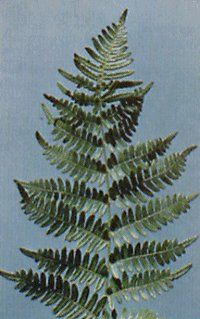BRACKEN FERN


Description
Bracken fern has broad, triangular leaves or fronds, that are divided into three main parts. Each part is segmented. The plant reaches a height of 2 to 4 feet. It grows directly from stout, black, horizontal rootstalks.

Bracken Fern is poisonous to cattle and horses; sheep are more resistant than other livestock.
In cattle, the disease takes an acute-usually fatal- form. Cattle poisoning often occurs during late summer when other feed is scarce, or whenever hay contains large amounts of bracken. In horses, the disease is chronic.
Livestock losses have been high in the Pacific Coast States, as well as in the Northeastern, Southeastern, and Midwestern States.
All portions of the fern-in both green and dry stages-are poisonous to livestock.

Where and When It Grows
Bracken fern grows on burned over areas, in woodlands and other shaded places, hillsides, open pastures, and ranges in dry, sandy, or gravelly soils.
The plant starts growth in the early spring and usually remains green until the leaves are killed by frost.

How It Affects Livestock
Bracken fern produces entirely different signs of poisoning in cattle and sheep than it does in horses.
This poisoning is cumulative. Livestock are affected only after they have eaten considerable amounts of bracken for 2 to 4 weeks.
In Cattle, sheep, and other cud chewing animals, there is a sudden onset of signs. The disease is of short duration and poisoned cattle usually die. Horses that eat bracken fern develope signs more slowly, and the disease becomes chronic. If affected horses are not treated, they will eventually die as a result of the bracken fern poisoning.

SIGNS OF POISONING
in cattle and sheep.....
1. High fever
2. Loss of appetite
3. Depression
4. Difficulty in breathing
5. Excessive salivation
6. Nasal and rectal bleeding; bloody urine
7. Hemorrhages on mucous membranes
In horses
1. Loss of weight and condition
2. Progressive incoordination
3. Marked depression
4. Crouching stance, back arched with legs apart
5. Twitching muscles
6. General body weakness
7. Weak, fast pulse
8. Animal unable to stand
9. Convulsions or spasms.

BACK TO INDEX
H O M E
Would You Consider Signing
My Book?








